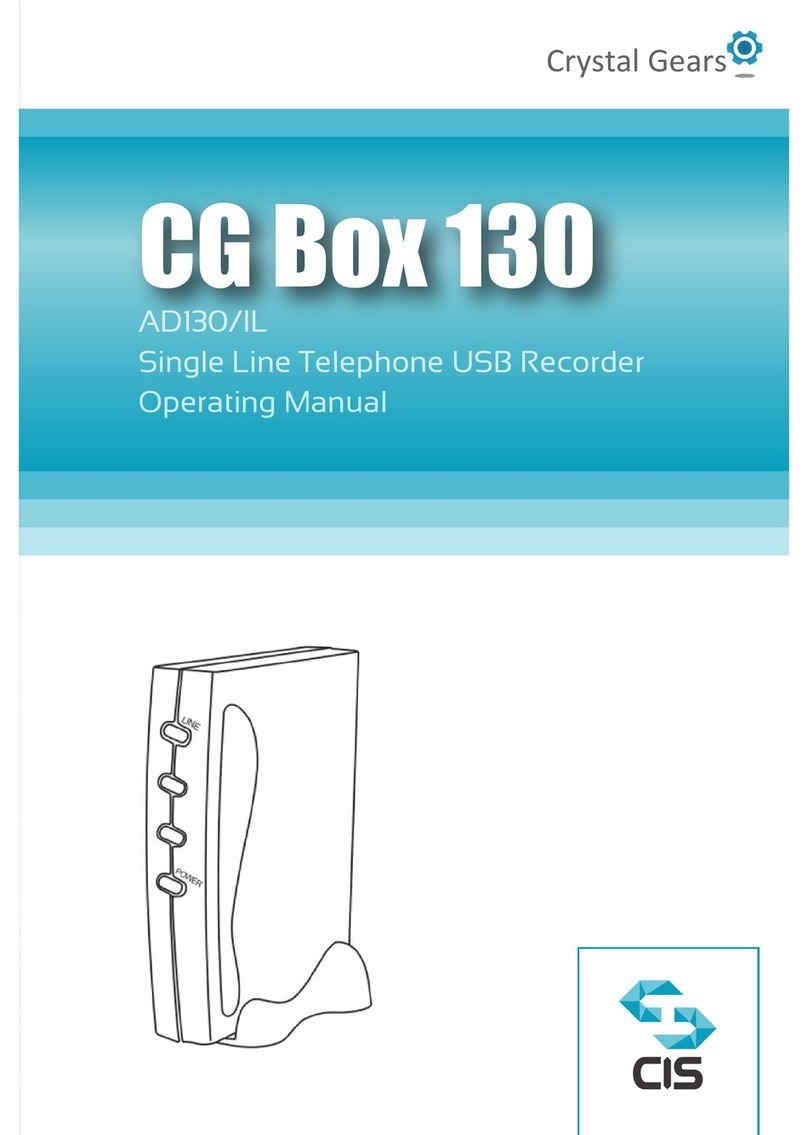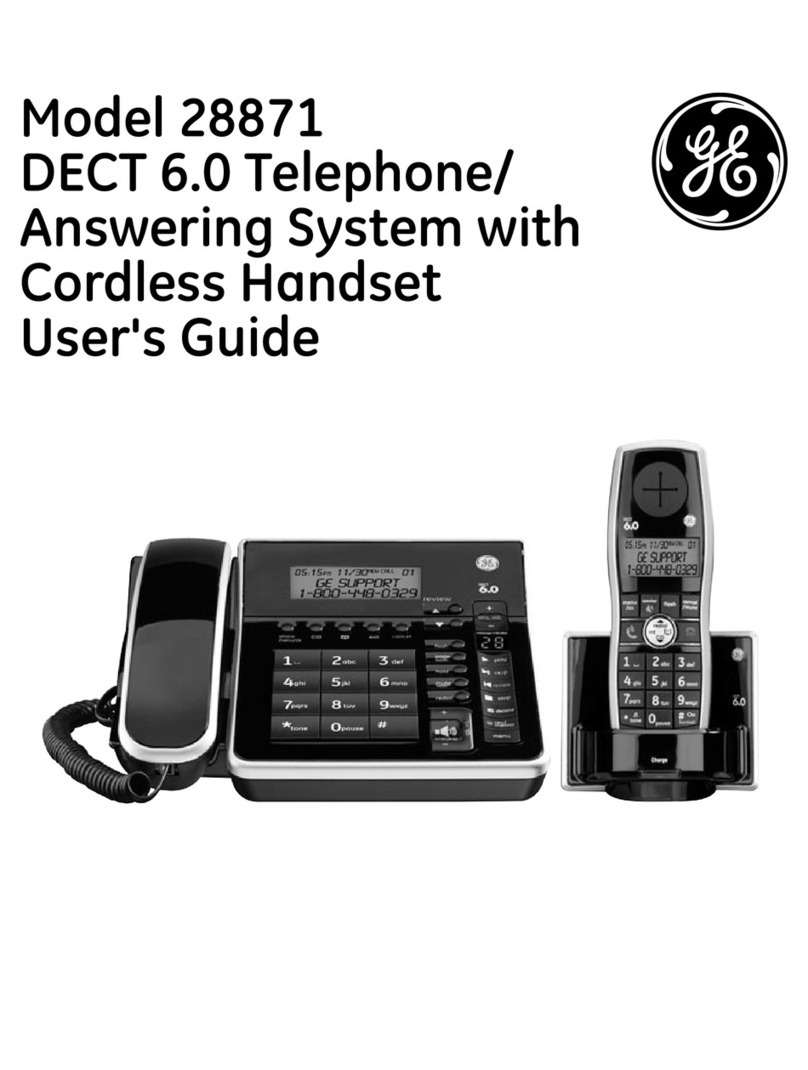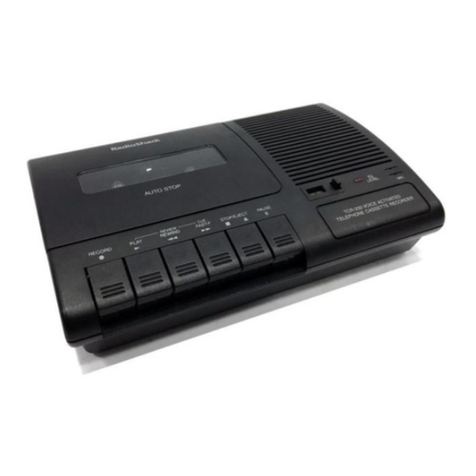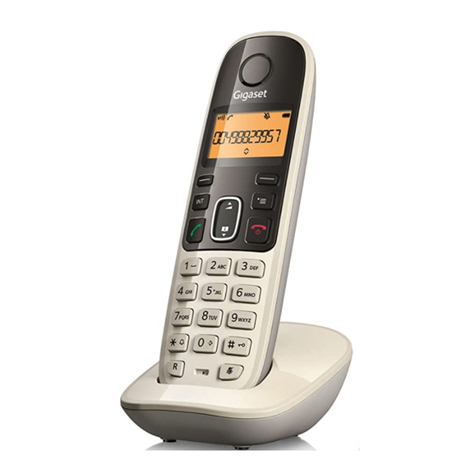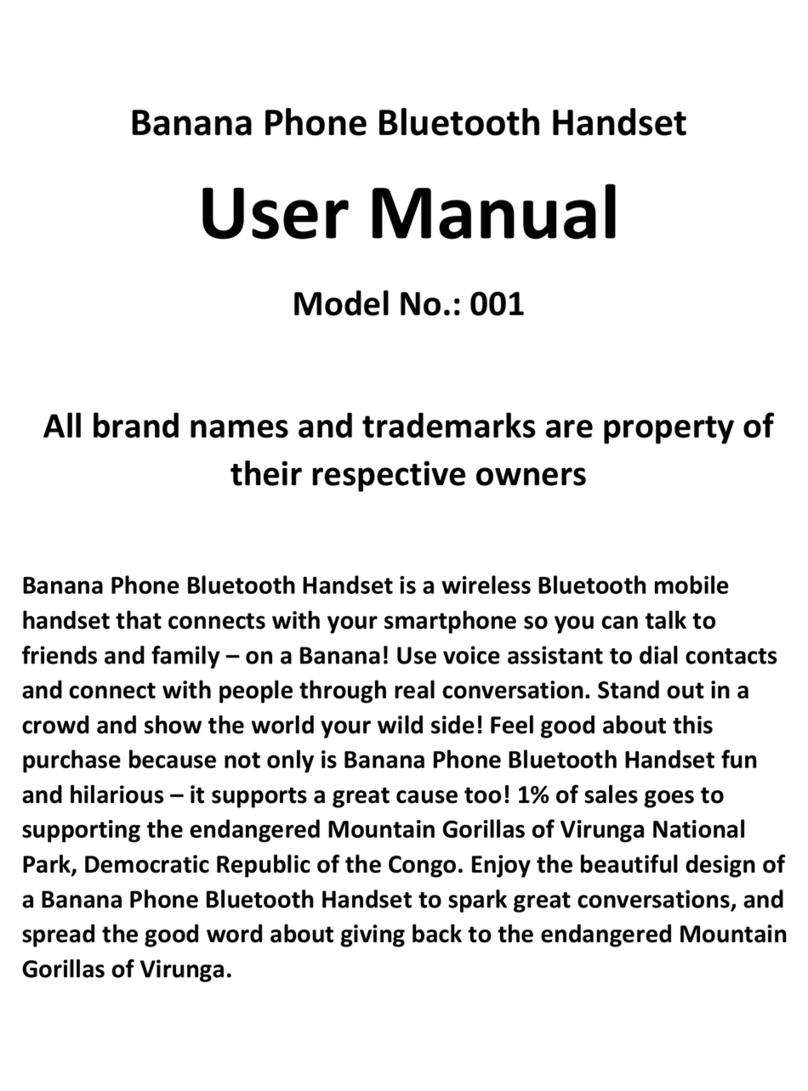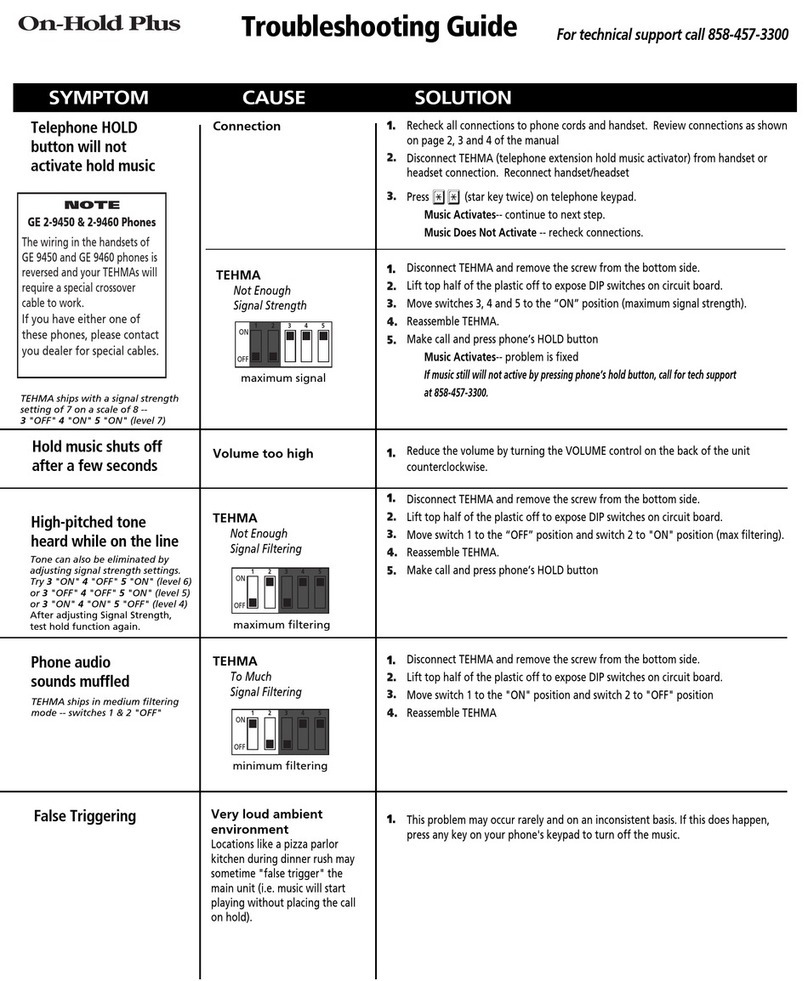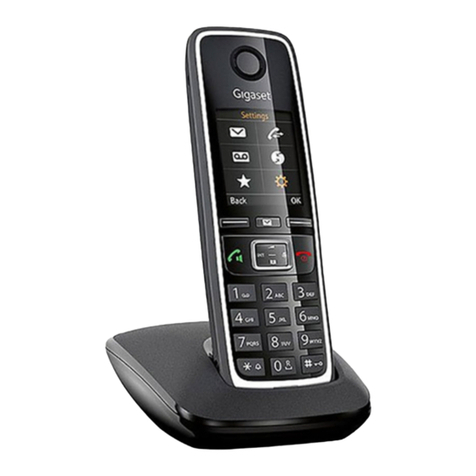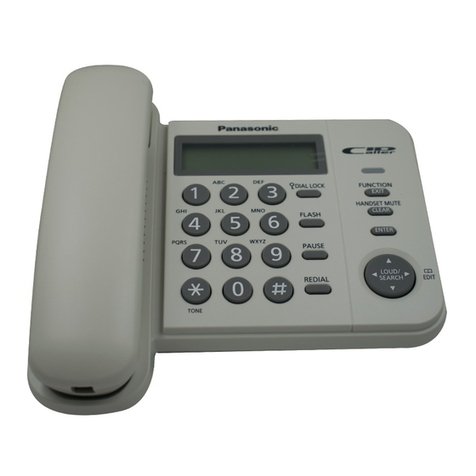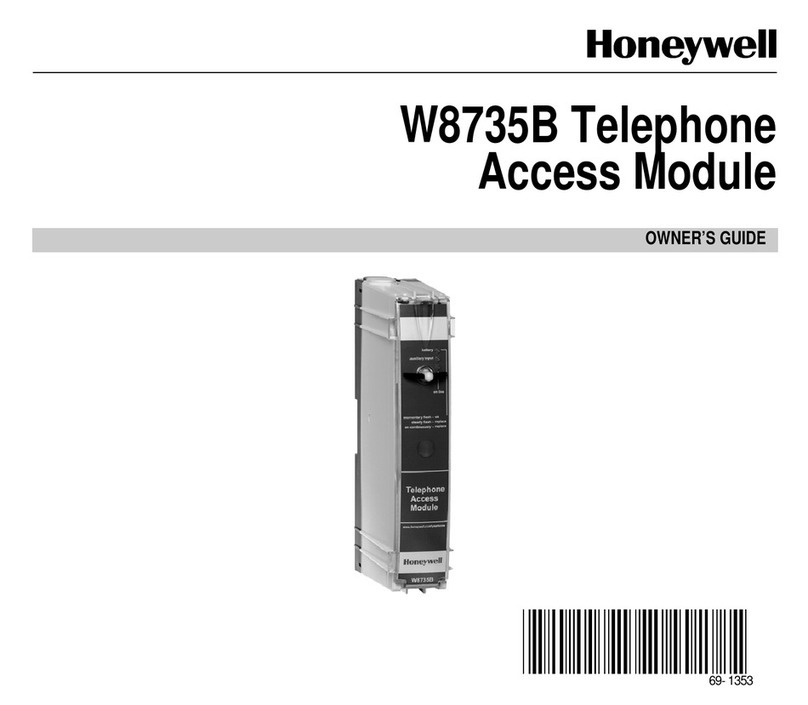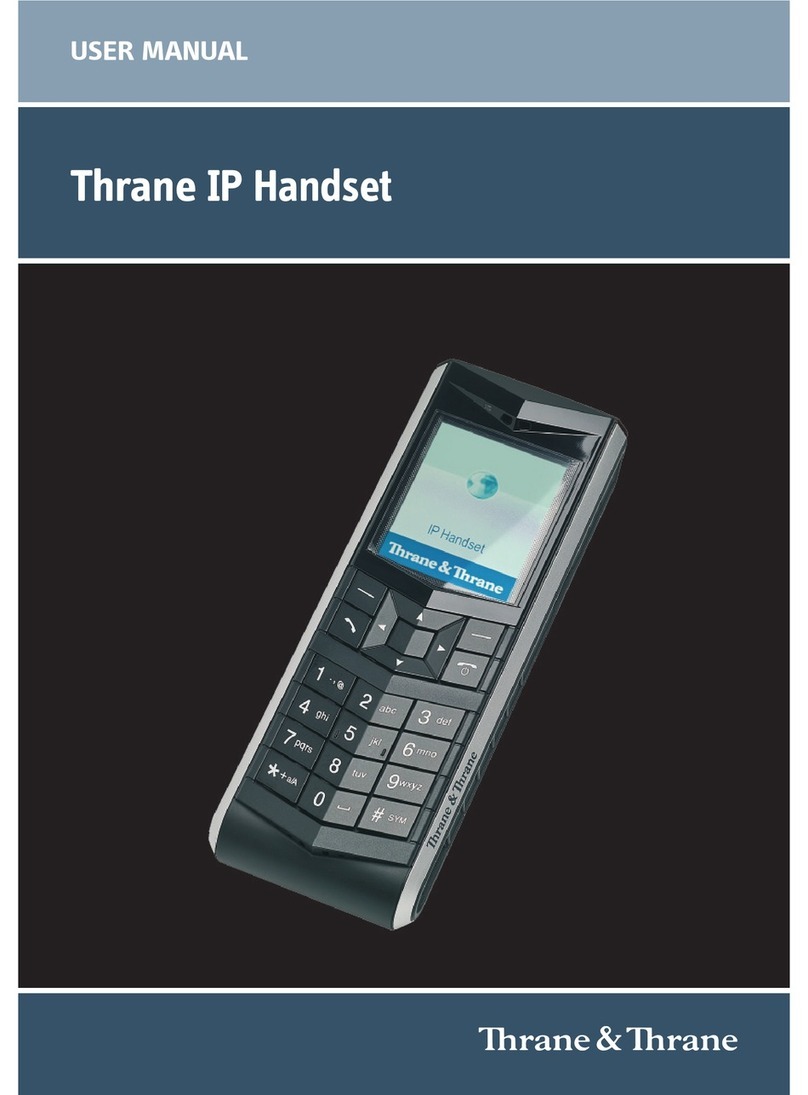Teletec international Minicom 6000 User manual

USING YOUR
MINICOM 6000™
305-007555

Teletec International, Ltd. (01234) 756026 (Voice)
Cranfield Innovation Centre (01234) 756027 (Text telephone)
University Way (01234) 756028 (Fax)
Cranfield Technology Park
Cranfield www.teletec.co.uk
Great Britain
Fifth edition
First printing
May 2007
© 2000-2007 Ultratec, Inc.
is a registered trademark of Teletec, Ltd.
Turbo Code is a registered trademark of Ultratec, Inc.
Minicom 6000 and Auto ID are trademarks of Ultratec, Inc.
Acknowledgement
In 1963, Dr. Robert H.Weitbrecht, an
American physicist who was deaf, developed
an acoustic coupler that could send and
receive teletypewriter signals over the
telephone lines. His invention, the
Weitbrecht Modem, enabled people who
are deaf to use the telephone for the first
time.
While modern technology now makes it
possible to build advanced microcomputer
devices like your new Ultratec text
telephone, the Weitbrecht modem remains
the major technological break-through that
began telecommunications for the deaf. Ultratec wishes to
acknowledge the importance of Dr.Weitbrecht’s contribution to the
welfare of people who are deaf the world over.
Dr. Robert H. Weitbrecht,
1920–1983, inventor of the
first TTY modem.

CONTENTS
Contents 1
Safety Instructions 4
CHAPTER 1 Introduction 5
Special Features 5
Overview of the Minicom 6000 6
Function Keys 7
CHAPTER 2 Setup 11
Selecting a Location 11
Making Connections 12
Setting the Clock + /OPTIONS 13
CHAPTER 3 Basic Calling 15
Making a Call in Direct Connect + /DIAL 15
About the Signal Light and Display 16
Dialling Tips 17
Answering a Call in Direct Connect 18
Acoustic Calling and Answering 19
CHAPTER 4 Advanced Calling 21
Auto ID™21
The Built-In Help Feature + /HELP 22
Turbo Code®22
Conversation Memory 24
The Greeting Memo + /GREETING 26
The Voice Announcer + /ANNOUNCER 26
Wait for Response + + 27
Changing to Another Text Telephone + + 27
Three-Way Calling + + 28
Transferring a Call + /DIAL 28
Sticky Keys 29
CHAPTER 5 VCO and HCO Calling 31
Direct Connect Setup for VCO or HCO 31
Using Different Codes for VCO/HCO 32
Using VCO in Direct Connect 32
Using HCO in Direct Connect 33
Using VCO or HCO in Acoustic Mode 33
1Ctrl
FShiftCtrl
CShiftCtrl
WShiftCtrl
SpacebarCtrl
4Ctrl
HCtrl
1Ctrl
9Ctrl
CONTENTS • 1

CHAPTER 6 Using TextDirect 34
CHAPTER 7 Auto-Answer 37
How Auto-Answer Works 37
About Auto-Answer Memory 37
Setting Up Auto-Answer + /AUTO-ANSWER 38
Turning On Auto-Answer + /AUTO-ANSWER 39
Interrupting Auto-Answer 40
Turning Off Auto-Answer 40
Reading Auto-Answer Messages 40
Changing the Outgoing Auto-Answer Memo + /AUTO-ANSWER 42
Auto-Answer Options 42
Retrieving Messages Remotely 43
CHAPTER 8 Memos 45
Saving a Memo + /MEMO 45
Sending a Memo + /SEND MEMO 47
Editing Memos + /MEMO 48
Clearing Memos 48
CHAPTER 9 Directory 49
Saving a Telephone Number + /DIRECTORY 49
Editing a Number + /DIRECTORY 51
Clearing Numbers in the Directory 51
CHAPTER 10 Options 53
Setting the Print Case + /OPTIONS 53
Setting the Print Style + /OPTIONS 54
Setting the Display Mode + /OPTIONS 54
Setting Pulse Dialling + /OPTIONS 55
Setting the Auto-Answer Rings + /OPTIONS 55
Selecting an Auto-Answer Memo + /OPTIONS 56
Setting the Auto-Answer Password + /OPTIONS 56
Selecting a Greeting Memo + /OPTIONS 57
Turning Off Printing of the Date and Time + /OPTIONS 57
Setting the Date and Time + /OPTIONS 58
Changing the Relay Voice Announcer Number + /OPTIONS 58
Turning Off Turbo Code + /OPTIONS 59
Turning Off Auto ID + /OPTIONS 59
Turning Off Interrupt + /OPTIONS 59
9Ctrl
9Ctrl
9Ctrl
9Ctrl
9Ctrl
9Ctrl
9Ctrl
9Ctrl
9Ctrl
9Ctrl
9Ctrl
9Ctrl
9Ctrl
9Ctrl
Back SpaceCtrl
Back SpaceCtrl
6Ctrl
5Ctrl
6Ctrl
+
=
Ctrl
Esc
Esc
Esc
+
=
Ctrl
+
=
Ctrl
2 • CONTENTS

Changing CCITT Seek Time + /OPTIONS 60
Turning Off the Auto-Answer Relay Voice Announcer + /OPTIONS 60
CHAPTER 11 Codes 61
Using EDT Code 61
Using CCITT Code 62
Using Baudot Code 65
Using the Danish Gateway 66
CHAPTER 12 Service 69
About the Batteries 69
Troubleshooting 71
Repair 73
European Union Declaration of Conformity 74
CHAPTER 13 Specifications 75
APPENDIX A Using an External Printer 77
Setting Up an External Printer 77
Turning the Printer On and Off + /PRINT 78
Other Printer Information 78
Setting the Print Style + /OPTIONS 78
Printing Memos + /MEMO 79
Printing Directory Numbers + /DIRECTORY 79
Index 81
Back SpaceCtrl
6Ctrl
9Ctrl
3Ctrl
9Ctrl
9Ctrl
CONTENTS • 3

4 • SAFETY INSTRUCTIONS
SAFETY INSTRUCTIONS
SAVE THESE INSTRUCTIONS!
Important safety instructions
When using your Minicom 6000™, basic
safety precautions should always be
followed to reduce the risk of fire, electric
shock, and injury to persons.
1. Read and understand all instructions.
2. Follow all warnings and instructions on
the Minicom 6000.
3. Unplug the Minicom 6000 from the wall
socket before cleaning. Do not use liquid
or aerosol cleaners. Use a damp cloth for
cleaning.
4. Do not use the Minicom 6000 near water,
for example, near a bath, kitchen sink,
laundry tub, in a wet basement, or near a
swimming pool.
5. Do not place the Minicom 6000 on an
unstable trolley, stand, or table. The
minicom may fall, causing serious
damage to the Minicom 6000.
6. The Minicom 6000 should be operated
only from the type of power source
indicated on the marking label. If you are
not sure of the type of power supply to
your home, consult your dealer.
7. Do not allow anything to rest on the
power cord. Do not locate the Minicom
6000 where people can walk on the cord.
8. Do not overload wall sockets and
extension cords. This overloading can
result in a fire or electric shock.
9.
To reduce the risk of electric shock, do not
take apart the Minicom 6000. Send it to a
qualified service person when service
work is required. Opening or removing
covers may expose you to dangerous
voltages or other risks. Incorrect re-
assembly can cause electric shock when
the minicom is subsequently used.
10. Avoid using a telephone (other than a
cordless type) during an electrical storm.
There is a remote risk of electric shock
from lightning.
11. Unplug the Minicom 6000 from the wall
socket and refer servicing to qualified
service personnel under the following
conditions:
(a) When the power supply cord or plug
is damaged or frayed.
(b) If liquid has been spilled into the
minicom.
(c) If the minicom has been exposed to
rain or water.
(d) If the minicom does not operate
normally. Adjust only those controls that
are covered by the operating instructions.
Improper adjustment of other controls
may result in damage and will often
require extensive work by a qualified
technician to restore the minicom to
normal operation.
(e) If the minicom has been dropped or
damaged.
(f) If the minicom works very differently
from the way you expect it to.
12. Do not use the minicom to report a gas
leak in the vicinity of the leak.
Battery safety
Caution: To reduce the risk of fire or injury
to persons, read and follow these
instructions:
1. Use only the type and size battery
specified in the battery instructions for
your unit.
2. Do not dispose of the batteries in a fire.
Cells may explode. Check with your
local council for possible special disposal
instructions.
3. Do not open or mutilate the batteries.
Released electrolyte is corrosive and may
cause damage to the eyes or skin. It may
be toxic if swallowed.
4. Exercise care in handling batteries in
order not to short them with conducting
materials such as rings, bracelets, and
keys. The battery or conductor may
overheat and cause burns.

INTRODUCTION
CHAPTER
1
Special Features
Welcome to the Minicom 6000™minicom (text telephone) from
Ultratec. Your new minicom has the following special features:
A Ring Indicator that tells you when someone is calling.
Turbo Code®communication protocol. This feature transmits signals
to other Turbo Code-equipped minicoms as fast as you can type.
Turbo Code also lets you interrupt the other person’s typing.
Auto ID™alerting system. Auto ID automatically alerts the answering
party that you are calling by minicom.
A Relay Voice Announcer that sends a voice message to tell callers to
use the Typetalk service.
Other features that make calling quick and easy are the following:
•Auto-Answer answers calls while you are gone and plays back
messages when you return or when you call from another minicom.
•Call progress displays RING or ENGAGED to let you know what is
happening on the telephone line.
•Keyboard dialling from the keyboard or memory.
•Call transfer and conference calling.
•32k memory—enough to save hundreds of Memos, telephone
numbers, and your conversations to review.
•Automatic display of the date and time on conversations saved
in memory.
•Sticky Keys, a feature that allows typing with only one finger if
necessary.
INTRODUCTION • 5

6 • INTRODUCTION
Overview of the Minicom 6000

Function Keys
Use the function keys to tell the Minicom 6000 to do something or to
change a setting. For example, use the Greeting function key (
/
GREETING
) to send the Greeting memo. Or, use the Options function
key ( /
OPTIONS
) to set the time and date.
Hold Down the Control Key to Use Function Keys
You must hold down the key and then press the function key to
use a function. For example, to dial, hold down the key while
you press the /
DIAL
key.
NOTE: If you have difficulty pressing two keys at one time, see Sticky
Keys on page 29.
Press the Escape Key to Quit a Function
When you use a function, you can use the key alone to quit
whatever you are doing. Changes are saved.
Esc
Esc
1
Ctrl
Ctrl
Ctrl
9
4
INTRODUCTION • 7

Diagram of Function Keys
This diagram shows the most important functions on the Minicom
6000.
8 • INTRODUCTION
ANNOUNCER

INTRODUCTION • 9
GA

Complete List of Function Keys
Dial + /
DIAL
Dials a telephone number p. 15
Hangup + /
HANGUP
Hangs up the telephone line p. 18
Print + /
PRINT
Turns on an external printer p. 78
Greeting + /
GREETING
Sends the Greeting memo p. 26
Send Memo + /
SEND MEMO
Sends a Memo p. 47
Memo + /
MEMO
Saves, edits or clears a Memo p. 45
Save + /
SAVE CONV.
Saves a conversation as a Memo p. 25
Conversation
Clear + /
CLEAR
Clears all or part of memory p. 25
Options + /
OPTIONS
Changes settings p. 53
Code + /
CODE
Changes codes p. 61
Auto-Answer + /
AUTO-ANSWER
Turns on Auto-Answer p. 37
Directory + / Saves telephone numbers p. 49
DIRECTORY
Help + /
Help
Explains how to use functions p. 22
Relay Voice + /
RELAY VOICE
Turns on Relay Voice Announcer p. 35
Announcer + / Turns on the Voice Announcer p. 26
ANNOUNCER
Interrupt + Interrupts other person’s typing p. 23
Time + Displays date and time p. 13
Wait for + + Flashes Ring Indicator when p. 27
Response on-hold ends
Three-way + + Uses three-way calling p. 28
calling telephone service
Change to + + Changes from Turbo Code to p. 28
Baudot Baudot code
Remain + /
REMAIN
Shows space in Memo/Directory p. 46
memory
Sensitivity + /
SENS.
Improves Baudot reception p. 71
Change to + + Puts call on hold to change to p. 27
another text another text telephone
telephone
CShiftCtrl
SCtrl
RCtrl
BShiftCtrl
FShiftCtrl
WShiftCtrl
TCtrl
ICtrl
SpacebarCtrl
VCtrl
HCtrl
Back SpaceCtrl
+
=
Ctrl
0Ctrl
9Ctrl
8Ctrl
7Ctrl
6Ctrl
5Ctrl
4Ctrl
3Ctrl
2Ctrl
1Ctrl
10 • INTRODUCTION

SETUP
SETUP • 11
The Minicom 6000 is simple to set up. You will need a mains power
socket to plug in the AC adapter and either: (1) a connection to a
standard telephone line or, (2) access to a telephone.
The best way to use the Minicom 6000 is to plug it into a standard
telephone line. This is called direct connect. See Selecting a Location
below for more information on direct connect. If you cannot plug the
Minicom 6000 into a standard telephone line, you can also make and
answer calls by placing a telephone handset in the Minicom 6000’s
acoustic cups.
Selecting a Location
The Minicom 6000 requires a standard (analogue) telephone line, the
kind found in most homes. Some businesses use digital telephone
systems. To use the Minicom 6000 with a digital system, use only the
acoustic cups. Do not connect the Minicom 6000 directly to the
telephone line of a digital telephone system. If you wish to use direct
connect, some modifications can be made to the digital system. If you
are not sure of the type of telephone line you are using, contact your
telephone installer.
Select a location to set up the Minicom 6000 where:
✔There is a mains power socket nearby
✔There is a phone jack nearby
✔Cords will not cross walkways
✔The Ring Indicator is easily visible
✔The surface it is set on is stable
✔The area is protected from excessive heat or humidity
CHAPTER
2

12 • SETUP
Making Connections
Pull the plastic tab out of the battery compartment on the bottom of
the Minicom 6000 before you plug in the AC adapter. The Ring
Indicator will not work if the tab is not removed and the batteries are
not fully charged.
The AC adapter supplies electricity to the Minicom 6000 and charges
the batteries. You should leave the adapter plugged in at all times. New
batteries will be fully charged after 24 hours. Once fully charged,
batteries will provide about 90 minutes of normal use without
electrical connection. For more information on using battery power,
see About the Batteries on page 69.
Step 3
Step 2
Step 1
Step 4
The illustration above shows how to set up for direct connect. This
means the Minicom 6000 is plugged directly into the telephone line.
In direct connect, you can dial from the keyboard and use Auto-Answer.
If, for some reason, you cannot plug a telephone line into the
Minicom 6000, you can connect by putting a telephone handset in the
acoustic cups. See Acoustic Calling and Answering on page 19 for
more information.
The Minicom 6000 comes set up for tone dialling, which is used by
most telephone lines. If your line uses pulse dialling, make sure the
minicom is set up for that. For more information, see Setting Pulse
Dialling on page 55.

Setting the Clock +/OPTIONS
The clock feature displays the date and time at the beginning of each
conversation, at the beginning of each Auto-Answer message and
whenever you press the Time key ( + ). You must set the clock
after you plug in the Minicom 6000 to display the correct date and
TCtrl
9
Ctrl
SETUP • 13
Return
Press
Return
…press
2nd
Press
1st
…
PRINT (UP/LOW) CASE
Hold
down…
…and
press
OPTIONS
time.
1. Press the Options key
(+/
OPTIONS
).
PRINT (UP/LOW) CASE is
displayed.
2. Press until you see
CHANGE CLOCK (NO).
Then, press the
to change the setting to
(YES).
3. Press . The date
and time are displayed
with the day flashing.
Return
Spacebar
Return
9Ctrl

Return
…press
2nd
Press
1st
…
4. Press the or the
key to set the
day. Then, press to
move to the next setting.
Press when you
finish to save changes
and exit this menu.
Esc
Return
Back Space
Spacebar
14 • SETUP

BASIC CALLING
BASIC CALLING • 15
CHAPTER
3
This chapter covers the basics of making and receiving minicom calls.
Making a Call in Direct Connect + /DIAL
1
Ctrl
1. Turn on the Minicom
6000.
2. Hold down the key
and press the /
DIAL
key.
1
Ctrl

3. Type the telephone
number you are calling.
Then, press to dial
the number.
While typing, you can
use the key to
correct mistakes.
4. When you see an answer
on the display, type a
greeting.
Turn off the Minicom
6000 when you are
finished with your call.
Back Space
Return
16 • BASIC CALLING
About the Signal Light and Display
The Signal light and the display show what is happening on the
telephone line (the display shows call progress in direct connect
only). The following chart explains what you see.
Signal Light Display Telephone Line
Stays on Dial tone
before dialling
Stays on No connection
after dialling
Flashes quickly ENGAGED Engaged
after dialling
Slow flashing RING Ringing
Irregular blinking The other person is picking
up the handset, speaking or
sending Voice Announcer
message.

Dialling Tips
Special Dialling Characters
You may need to type a ‘9’ or other number to reach an outside line if
you are using the Minicom 6000 in an office. The exact method of
dialling will depend on your local telephone system. Dialling a text
telephone call should be the same as dialling a voice call.
Use a comma to put in a one-second pause.
For example:
9,01234 756026
Use an ‘!’ for a timed break recall. A timed break recall is used in a
voice mail system or to transfer a call.
You cannot use ‘*’ and ‘#’ with pulse dialling.
Redialing the Last Number + /DIAL
Follow these steps to redial the last number you dialled:
1. Press the Dial key ( + /
DIAL
). TYPE NAME, NUM, OR CR is
displayed.
2. Press .
Dialling from the Directory + /DIAL
You can dial from the Directory if you have numbers saved. Follow
these steps to dial from the Directory:
1. Press the Dial key ( + /
DIAL
). TYPE NAME, NUM, OR CR is
displayed.
2. Type a name or press the to review the list of Directory
names.
3. Press when you find the name you want. The Minicom
6000 will automatically dial the number.
Return
Spacebar
1Ctrl
1Ctrl
Return
1Ctrl
1Ctrl
BASIC CALLING • 17
Table of contents

